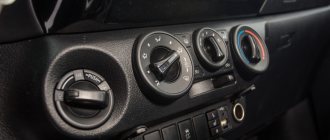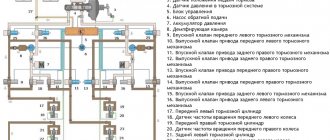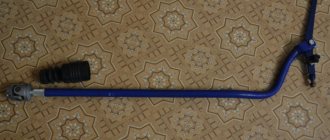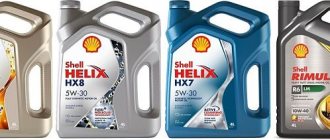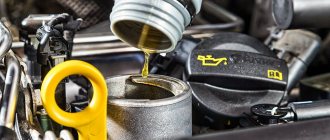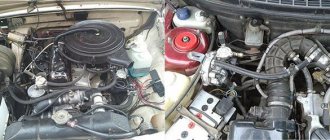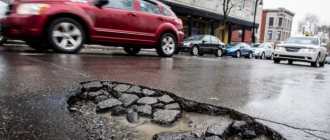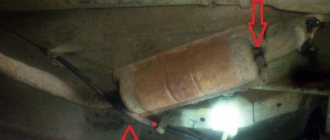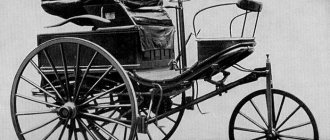The road is a source of increased danger and requires special attention. Automakers improve their cars every year, regularly upgrading designs and introducing new safety technologies.
In this article we will tell you what the safety of a car depends on, who checks it and how, we will look at the functionality of the most popular systems, and we will also name several of the safest popular cars in our country.
You can see all the cars with high safety scores on our website - in the safe cars section.
What are the types of active safety systems?
- Anti-lock.
Measures braking, breaking it into several fragments, preventing complete blocking of the wheels and the car skidding. Allows you to achieve maximum braking efficiency and safety. - Anti-slip.
Prevents the drive wheels from slipping when there is insufficient traction - Distribution of braking forces.
As a rule, it uses structural elements of the anti-lock braking system. Allows you to distribute braking forces between axles and/or wheels, helping to maintain the trajectory of movement and reduce the likelihood of skidding when braking on uneven road surfaces and when cornering. - Emergency braking assistance.
Recognizes emergency braking, usually by the force and speed of pressing the brake pedal. If necessary, instantly increases the pressure in the brake system to maximum, providing maximum braking efficiency. - Electronic differential lock.
Activated when one of the wheels of the drive axle slips, it slows down, providing an increase in torque on it. Based on ABS. - Dynamic stabilization.
Includes previously listed systems. Function of the exchange rate stability system: stabilization of movement in the event of risk or loss of control.
What is active safety
In addition to the passive system for protecting people in road accidents, there is an active one. This is a set of technical and operational capabilities of a machine that help prevent an accident and reduce its risk. That is, active and passive safety of a car are not the same thing. The first was invented so that the second would not be necessary. Active system components:
- anti-lock brake system;
- a set of anti-slip components;
- a set of elements that ensure the stability of the car;
- features of the braking system that make it possible to stop urgently and distribute forces to all moving parts of the vehicle;
- differential lock, forcing all wheels to rotate regardless of the situation on the road.
More on AutoLex.Net:
Illegal vehicle inspections will be criminalized in Russia as of July 27
It can be supplemented by parking sensors, cruise control, auxiliary descent and ascent systems, and a hand brake.
Elements of passive safety of the vehicle made it possible not to be afraid of high speeds and bad roads. But this will only be possible if the system is in proper condition. Therefore, it is important for car owners to monitor its serviceability and not forget about the rules.
Why are assistance systems needed?
Modern cars are also equipped with a host of assistance systems designed to facilitate control in potentially difficult or dangerous situations. The most common systems of this type are:
- Parking assistant.
Helps in parking by sounding signals when there is a threat of collision. The system can be equipped with a rear view camera or all-round cameras that display the image on a display in the cabin. - Adaptive cruise control.
Unlike standard cruise control, the system uses sensors to receive information about the speed of the vehicle in front and the distance to it, which allows the car to change the driving mode without driver intervention depending on the previously specified variables. - Lane Keeping Assist System.
Monitors road markings and warns the driver if he performs a dangerous maneuver. - Also used are systems for recognizing road signs, monitoring the driver’s condition, monitoring “dead” spots, assisting when descending a mountain, and assisting when starting off on a hill
.
Active and passive vehicle safety systems
According to research, 80 to 85% of transport accidents and disasters occur in cars. Auto manufacturers understand that vehicle safety is an important advantage over competitors in the market, and also that the safety of one car determines the safety of traffic on the road as a whole. The causes of accidents can be different - this is the human factor, and the condition of the road, and meteorological conditions, and designers have to take into account the whole range of threats. Therefore, modern safety systems provide both active and passive vehicle protection, and consist of a complex set of various devices and devices, from anti-lock wheel systems (hereinafter referred to as ABS) and anti-skid systems to airbags.
Active safety and accident prevention
A reliable vehicle allows the driver to save his life and health, and at the same time the life and health of passengers on modern, crowded highways. Car safety is usually divided into passive and active. Active refers to those design decisions or systems that reduce the likelihood of an accident.
Active safety allows you to change your driving pattern without fear of the vehicle spinning out of control.
Active safety depends on the design of the car; the ergonomics of the seats and the interior as a whole, systems that prevent glass from freezing, and visors are of great importance. Systems that signal breakdowns, prevent brakes from locking, or monitor overspeeding are also classified as active safety.
The visibility of a car on the road, which is determined by its color, can also play a role in preventing an accident. Thus, bright yellow, red and orange car bodies are considered safer, and in the absence of snow, white is added to their number.
At night, active safety is ensured by various light-reflecting surfaces that make the car visible in the headlights. For example, license plate surfaces coated with special paint.
Convenient, ergonomic placement of instruments on the dashboard and visual access to them contribute to the prevention of accidents.
Click on the picture to enlarge
If an accident does occur, the driver and passengers are protected by passive safety equipment and systems. Most of the special devices and passive safety systems are located in the front part of the cabin, since in the event of an accident, the windshield, steering column, front doors and dashboard are the first to be affected.
Seat belts are a simple and cheap product that is extremely effective.
Currently, in many countries, including Russia, their availability and use is mandatory.
A more complex passive protection system is the airbag.
Originally created as an alternative to a belt and a means to avoid injuries to the driver’s chest (injuries from the steering wheel are one of the most common in accidents), in modern cars airbags can be installed not only in front of the driver and passenger, but also mounted in the doors for this purpose. to protect against side impact. The disadvantage of these systems is the extremely loud sound when they are filled with gas. The noise is so loud that it exceeds the pain threshold and can even damage the eardrum. Also, airbags will not save you if the car rolls over. For these reasons, experiments are being carried out on the introduction of safety nets, which will later replace airbags.
During a frontal impact, the driver has the opportunity to injure his legs, therefore, in modern cars, pedal units must also be injury-proof. In the event of a collision, the pedals are separated in such a unit, which helps protect your legs from injury.
Click on the picture to enlarge
Backseat
Child car seats and special belts that securely secure a child's body and prevent him from moving around the cabin in the event of an accident can ensure the safety of very young passengers for whom regular seat belts are not suitable.
If a sudden overload occurs on the passenger’s torso, there is a possibility of damaging the cervical vertebrae. Therefore, the rear seats, like the front ones, are equipped with head restraints.
Reliable fastening of the seats is also very important: the passenger seat must withstand an overload of 20 g in order to ensure proper safety in the event of an accident.
Design Features
As already mentioned, the car itself must be designed in such a way as to ensure maximum safety for people. And this is achieved not only by ergonomics. Not least important is the strength of various structural elements. For some elements it should be increased, while for others it should be the opposite.
So, in order to ensure reliable passive safety for passengers and the driver, the middle part of the body or frame must have increased strength, and the front and rear parts - on the contrary. Then, when the front and rear parts of the structure are crushed, part of the impact energy is spent on deformation, and the stronger middle part easily withstands the collision and does not deform or break. Those parts that should be crushed upon impact are made of brittle materials.
The steering wheel must withstand the impact without breaking the driver's sternum or ribs.
Therefore, steering wheel hubs are made of large diameter and covered with elastic shock-absorbing materials.
Glass in cars also serves the purpose of passive safety: unlike ordinary window glass, it does not break into large pieces with sharp edges, but crumbles into small cubes that cannot cause cuts to either the driver or passengers.
Technology at the service of active safety
The modern market offers many reliable and effective active safety systems. The most common and well-known are anti-lock braking systems, which prevent wheel slipping that occurs when the wheels lock. If there is no slipping, then the car does not skid.
ABS allows you to perform maneuvers during braking and fully control the movement of the vehicle until it comes to a complete stop.
The ABS electronics receives signals from the wheel rotation sensors. It then analyzes the information and, through a hydraulic modulator, influences the brake system, “releasing” the brakes for short periods of time so that they turn. This allows you to avoid skidding and sliding.
Traction control systems are built on the structural basis of ABS, which analyze data on wheel speed and control engine torque.
Stability control systems improve vehicle safety by maintaining the direction of travel. Such devices themselves can determine an emergency situation by interpreting the driver’s actions in comparison with the vehicle’s movement parameters. If the system recognizes the situation as an emergency, it begins to correct the movement of the car in several ways: by braking, changing the engine torque, and adjusting the position of the front wheels. There are devices that also signal the driver about danger and increase pressure in the brake system, increasing its efficiency.
Pedestrian detection systems can reduce the fatality rate of pedestrians hit by 20%. They recognize a person based on the vehicle's heading and automatically reduce its speed. The use of a special airbag for pedestrians in combination with this system makes the car even safer for those who do not have a car.
In order to prevent the rear wheels from locking, a pressure redistribution system is used. Its task is to equalize the brake fluid pressure based on sensor readings.
conclusions
The use of active and passive safety systems reduces the risk of an accident and injury if an accident does occur.
Passive safety is built around absorbing impact energy from parts of the body, engine or passenger's body and preventing dangerous deformations of the structure that can lead to injury to people in the cabin.
Active safety is aimed at warning the driver about a threat and adjusting control systems, braking, and changing torque.
Technologies in this industry are developing rapidly, and the market is constantly being filled with new, more modern and efficient systems, making road traffic safer every year.
What are preventative security systems?
On many modern cars, some of the listed active and assistive systems are combined into large-scale technical systems of the so-called intelligent preventive safety using special software.
Their task is to prevent a collision, pre-prepare the braking system for braking, prepare for the activation of some passive safety systems, and also automatically change the speed of movement until a complete stop. Such electronic assistants include Collision Warning with Brake Support from Ford, Collision Warning with Auto Brake and City Safety from Volvo, Front Assist from Volkswagen, etc.
Important elements of the passive safety system
When the vehicle suddenly brakes or collides with an obstacle, people in the vehicle will inevitably come into contact with the equipment components inside. They are the passive safety system. The concept includes:
interior “box”;- restraints (belts and child seats);
- airbags;
- steering column that folds upon impact;
- pedal assembly, which protects against injury due to separation from the mount in the event of an accident;
- soft parts of the interior upholstery;
- seat headrests;
- having special properties of glass, which, when broken, are destroyed into small, non-traumatic fragments;
- a system for moving the engine and other components away from the passenger compartment upon impact;
- reinforced arches, roof pillars, glass frames, which do not allow the body to be severely damaged.
These components are designed so that they do not cause additional injuries to a person and soften the blow.
What does the list of passive safety devices and mechanisms include?
So, we have looked at systems that directly or indirectly prevent a collision, and then we will talk about the devices, mechanisms and design features responsible for passive safety in a car. That is, about elements that provide protection from injury directly in the event of a collision.
- Airbags (chest, front, knee, central, pedestrian);
- Curtain airbags (head airbags);
- Seat belts;
- Child seats or mountings for them, special belts;
- Head restraints (regular or active);
- Safety glass;
- Safety pedal assembly.
A significant criterion for passive safety is also the special body design, which involves absorbing collision energy by crushing the front or rear of the car. In the event of a frontal impact, the engine and other units, components and mechanisms located in the engine compartment are retracted under the bottom of the car. This reduces the risk of severe injuries to the driver and front passenger. Despite the relatively easily deformed front and rear parts, the interior frame (pillars, roof frame, sills) has high strength and rigidity. This also has a positive effect on the reliability of protection for people in the car.
It is important to understand that, despite all the technology, the main “safety system” of a car is an attentive, collected and responsible driver, and everything else is just assistants and insurance.
General requirements
Passive safety equipment must meet the following conditions:
- do not have sharp corners or edges that could lead to additional injuries;
- be manufactured in accordance with GOST standards in terms of dimensions and design features;
- exclude the possibility of incorrect use;
- maintain its qualities during the entire period of operation;
- operate in a certain way only during an accident and not during normal driving.
Requirements for the passive safety of a car are formed on the basis of tests (crash tests). In Russia they are contained in GOSTs 18837-73 (seat belts), 21936-76 (body), 24309-80 (head restraints) and many others. All manufactured vehicles must comply with UNECE Rules. People in the car must survive if:
- hitting a standing obstacle at a speed of 14 m/s;
- collision at a speed of 19 m/s;
- impact from behind with an object weighing less than 1250 kg at a speed of 22.2 m/s;
- side impact at right angles at a speed of 9 m/s;
- turning over twice or three times at an initial speed of 14 m/s.
More on AutoLex.Net:
How to choose a car fire extinguisher
What are crash tests and who conducts them?
A crash test is an event in which an accident is deliberately reproduced in specially equipped testing grounds. Today, such tests are carried out by many organizations: from the automakers themselves to independent road safety institutes. Of course, each of them has its own system.
| Organization | Euro NCAP (European Union) | NHTSA (USA) | IIHS (USA) | ANCAP (Australia) | JNCAP (Japan) | KNCAP (South Korea) | C-NCAP (China) | Latin NCAP |
| Frontal kick | ||||||||
| Non-deformable barrier, overlap - 100% | — | 56 km/h | — | — | 55 km/h | 56 km/h | 56 km/h | — |
| Non-deformable barrier, overlap - 25% | — | + | 64 km/h | — | — | — | — | — |
| Deformable barrier, overlap - 40% | 64 km/h | — | 64 km/h | 64 km/h | 64 km/h | 64 km/h | 64 km/h | 64 km/h |
| Side impact | ||||||||
| Cart | + | + | + | + | + | + | + | — |
| Pillar | + | — | — | + | — | + | — | — |
| Other tests | ||||||||
| Armchairs | + | — | + | — | + | + | — | — |
| Pedestrian safety | + | — | — | + | — | + | — | — |
| Efficiency of electronic systems | + | — | + | — | — | + | — | — |
| Possibility of capsizing | — | + | — | — | — | + | — | — |
It is worth noting that the listed organizations have strict requirements for vehicle safety, which allows us to have no doubt about the impartiality of the tests.
Rating of safe cars from FAVORIT MOTORS
Volkswagen Passat (according to IIHS in 2016). A modern city sedan that has won a 5* safety rating, complemented by a solid appearance and outstanding driving performance.
Volkswagen Tiguan (according to Euro NCAP in 2016). A crossover that boasts not only a high level of safety, but also an exemplary interior - the standard of modern automotive ergonomics. The new generation kept all these qualities with them.
Volvo XC90 (according to IIHS and Euro NCAP versions in 2016). An SUV that was tested for two years in a row and received the highest safety mark with the same frequency. Comfortable, impressive, trained in special manners - a real aristocrat.
Ford Mondeo (according to Euro NCAP in 2014). A car that has grown from the “middle” class to a full-fledged executive car. Solid and at the same time aggressive design, efficiency and excellent dynamic qualities, reliability and quality, relatively low cost and 5 stars of safety.
KIA Optima (according to Euro NCAP in 2015). Safe business class at an affordable price.
Risk factors and protection against them
Passive safety system of a car
The main task of the safety system is to protect the life and health of people inside the car. Currently, the system is aimed not only at those inside, but also at pedestrians. New, more effective methods and technologies for protecting people are being developed.
Head-on collision
A collision between two cars moving at high speed poses an increased danger, which requires special calculations and the use of new technologies and the use of appropriate structural materials.
In the event of a frontal collision, the system performs the following tasks:
- Impact energy absorption;
- Protecting passengers from death and injury;
- The ability to get out of the car after a collision.
The vehicle's speed must be reduced smoothly to avoid a sudden impact. The longer the deceleration occurs, the smoother it is. This measure allows the bodies of people in the cabin to slow down as slowly as possible. The design of the car body is made in such a way that the front part is soft enough, that is, it is easily crushed. It acts as a buffer. The part of the body located directly around the passengers has a rigid, durable structure. This was done so that it would not be crushed, otherwise people would be trapped inside.
The next element of protection is airbags in combination with seat belts. This combination keeps the body from moving forward in a frontal impact. The airbag and seat belt work together. The electronic unit monitors the required parameters and exerts corresponding control actions on both the pillow and the belt tensioner. The opening of the first should not be too sharp. Otherwise, the person may become deaf or suffocated. At the moment of impact, the belt tensioner creates more force to keep the body from moving forward. A tight belt will place high pressure on the area of the body underneath it. Therefore, the belt can move, but with force, slowing down the person’s movement.
The driver's legs are protected by allowing the pedal assembly to be separated, which reduces the risk of fracture.
Body elements are manufactured in such a way as to ensure maximum rigidity and protection against deformation. Door locks are designed so that even in the event of a severe collision it is possible to open them.
Side collision
If in a frontal impact there is a buffer (front part) between the people inside the car and the obstacle, then in a side impact the situation is different. The impact speed at such a moment is usually less than during a frontal collision. However, this does not greatly reduce the danger.
Due to these characteristics of the impact and, consequently, the low protection of people inside the cabin, the door design is made with stiffening bars. In addition to the technology of the body itself, side airbags are used.
Rear collision
During a rear impact, the car moves forward, i.e. passengers and the driver will be pressed against the back of the seats. The movement of the human body occurs until it encounters an obstacle, which is the seat. Providing an obstacle to the head is very important to prevent a neck fracture. The function to achieve this goal is performed by the head restraints. There are active head restraints driven by electric drives. The latter are activated by the electronic control unit. The role of the buffer is performed by the bumper and the rear part of the body.
